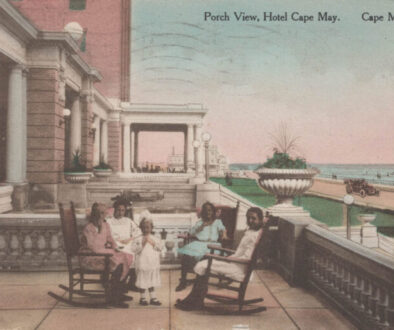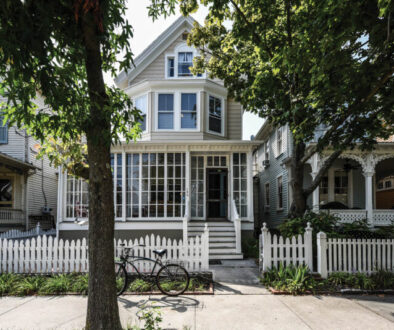Interior Motives
Color It Pretty
Color is all around us. From the moody blue greens of the Atlantic Ocean and the green-to-gold dune grasses on our beaches to bright red stop signs and bold striped awnings, color brightens our surroundings and catches our eye, transforming bleak landscapes to ones that excite and inspire. And don’t even get us started on rainbows, flowers, and sidewalk chalk—color is everywhere, and it is wonderful.
Why, then, do so many of us resist using color in our homes, sticking to the safety of creams and whites, beiges, and tans?
“A lot of people are intimidated by color and their first reaction might be ‘I don’t like color’,” says Erin Daniels of Cape May Decorating Co. “In people’s minds, color is the rainbow. Bright, primary colors, or a box of crayons. They’re not thinking of the subtleties and the faint shades of colors that you can use. So, I think just the word ‘color’ sometimes intimidates people.”
Daniels is an expert on the topic. A watercolor artist, her design specialty is color consultation. This designer has the unique ability to recognize the color within other colors and to select the perfect hues for both her clients as well as her artwork.

So how does she help guide people to explore color?
“Sometimes people will flat out say they’re afraid of using or even picking a color,” says Daniels. “I’ll say, ‘let’s take a look at a fan deck and you just point, show me what you like, what appeals to you.’ People can look at something and point to it and not know the words to use, but they know what they like and dislike. You could have the most indecisive person, but I’m pretty sure I could get them to point to two colors and say, ‘I like this one and not that one.’”
Of course, different people have different preferences. One person’s subtle use of color is another person’s daring incorporation of a new hue.
“For the most part, when I walk into someone’s home, I can tell right away how comfortable they are using color,” says Daniels. “I guess intuitively, I can tell how far I can push someone. If I got into somebody’s house and it’s all neutrals—which is fine, it’s their preference—I’m not going to suggest doing an orange wall or something.”
More than that, Daniels, like most designers, has tons of experience not just with customers but with color as a stand-alone concept. As a professional, she can guide both the design-intimidated just as well as the bolder client.
“Sometimes it’s just the intimidation of looking at that little one-by-one inch square of color and they can’t visualize how it would look on the walls,” says Daniels. “Like, I see you like this pink for your daughter’s room, but I know from experience that if you put this pretty pink on four walls, it’s going to be glowing and keep her up at night. I see where you’re going and get a sense of what you want, and this is not going to get you there. Let me show you some other options.”
A designer is always a great option. But what about those who want to go the DIY route? When people are selecting paint colors, paint swatches are the starting point. And while most DIYers tend to either tape or hold paint swatches against a wall—or even paint samples directly onto it—Daniels has another suggestion.
“If you’re going to pick a bold color, or even any color, paint yourself a large swatch on white poster board, not on the wall,” says Daniels, who recommends leaving the edges of the poster board white. “Say your walls are green and you want them to be pink, and you paint a huge square of pink on the wall. First, the green underneath is going to most likely show through unless you do two or three coats of a good paint. And your eye is seeing that green around the pink as you’re looking at the wall, which affects the way you see the pink. You want to isolate the color, so your eye is really seeing it.”
Sample pots of paints are great, but keep in mind that those aren’t necessarily the same formula as the paint you’ll later buy. Because they are thinner and with less pigment to them, you’ll want to add several coats to your poster board to have an accurate representation of the color you’re shooting for.
Likewise, play around with your large sample or samples. While you can always paint over a color you don’t like, it’s a lot more efficient to pick a good color from the get-go.
“Move it around. Put it in a shadowy corner. Put it in a bright part,” says Daniels. “Some people are fine with making a decision and just accepting that they have to live with it. For most people, I recommend living with [the sample] for at least a couple of days where you can see it at different times of day. You’re looking at it at night with your lights on, with your lights off—even sunny days and cloudy days can make a difference. Just put it up on the wall and when you walk in the room and glance at it. Does it feel good? Or is it like ‘Whoa, that’s a lot.’”
Furthermore, Daniels urges caution when choosing a color based off a popular site like Pinterest. She cites the many variables that can affect the way a color looks in any of the pictures, or in a particular house. These include the direction the room faces, the color of the floors, the natural light, and the fixed finishes, countertops, and cabinets, among others.
Picking a color is one thing, but aren’t there some rules we need to follow?
“I have seen people break every rule and have it look amazing,” says Daniels. “I think getting into color theory with someone is making it way more complicated. People know what they like when they see it.” Though Daniels doesn’t rely on specific rules regarding color theory and color schemes, she does recommend a few things to make a home feel cohesive.
“Part of it is using the right color placement for the type of home you have,” says Daniels. “If you have an open concept house, and you’re going to be seeing a lot of different walls and a lot of different spaces at the same time, you probably don’t want them to be six different colors, because it’s a lot for your eye to be looking at. You also don’t want to have neutrals on all your walls and then have one room be bright orange. It just doesn’t work. It’s jarring.”
If you do choose to paint every room a different color, Daniels recommends choosing colors that all work together and flow well. That type of flow, and the addition of unifying elements, can add to the cohesiveness of the home.
“I would recommend keeping trim and things like that the same throughout the house. It gives your eye a place to rest,” says Daniels. “And if you’re going to be using bold colors, I would say pick some kind of neutral you could use throughout the house that would be a unifying visual with white or linen color or even black, so you can have a little bit of it at least in each room to tie everything together.”
For those of us already sold on color, but worry about our changing tastes and styles, Daniels has some non-paint suggestions.
Color trends come and go. Remember millennial pink? It’s long gone. Dark, moody greens and navy blues have been big more recently, but those too are starting to wane in popularity. And the Pantone Color of the Year—Veri Peri, a bold periwinkle—is stunning and eye-catching, but something that seems unlikely to be found as the primary color in someone’s living room.
“I always say to people, you can always incorporate color with your artwork or with your accessories, pillows, throws—things that are easy to change. Because even if it’s a bold color and you love it now, you may not always,” says Daniels. “Changeable elements are where you can take a risk.”
The key, of course, is finding what works for you.
“I may know this color is going to technically look better than this other one, but if you’re not comfortable with it, then what’s the point?” says Daniels. “It’s your house.” ■



